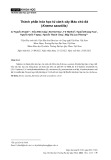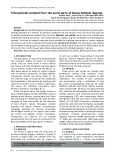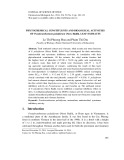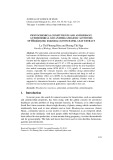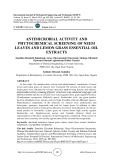
Phytochemical constituents
-
Phytochemical study of Knema saxatilis stems led to the isolation of six known compounds. Their chemical structures were determined as 8-hydroxy eriodictyol (1), (2S)-7-hydroxy-3′,4′-methylenedioxideflavan (2), sitostenone (3), protocatechuic acid (4), 4-hydroxybenzoic acid (5) and vanillin (6) using NMR and MS spectral data.
 7p
7p  viyoko
viyoko
 01-10-2024
01-10-2024
 1
1
 1
1
 Download
Download
-
Buxus latistyla Gagnep. (Buxaceae) has been used as a remedy for treating malaria, haemoptysis, amoebic dysentery etc. However, its chemical constituents are still unknown. Thus, the aim of this study was to identify phytochemicals isolated from this plant.
 7p
7p  vifaye
vifaye
 20-09-2024
20-09-2024
 4
4
 1
1
 Download
Download
-
The methanol extract of P. palatiferum (Nees) Radlk. leaves exhibited a moderate inhibitory effect on the L-3,4-dihydroxyphenylalanine (L-DOPA) oxidase activity of tyrosinase in the melanin biosynthesis pathway. Further study may lead to new bioactive compounds from ethyl acetate and n-hexane fractions.
 11p
11p  tamynhan5
tamynhan5
 10-12-2020
10-12-2020
 28
28
 2
2
 Download
Download
-
This fraction showed the highest antioxidant activity by dose-dependent free radical scavenging action (IC50 69.50 ± 1.55 µg/mL). R. tomentosa leaf extracts, especially the n-hexane fraction, also exhibited strong antimicrobial activity against Gram-negative and Gram-positive bacteria and fungi as well as moderate inhibitory effect on L-DOPA (L-3,4-dihydroxyphenylalanine) oxidase activity of tyrosinase in the melanin biosynthesis pathway.
 9p
9p  tamynhan8
tamynhan8
 04-11-2020
04-11-2020
 13
13
 1
1
 Download
Download
-
In this study, the antimicrobial activity and phytochemical constituents of neem leaves and lemon grass oil extracts were evaluated. Oil extracts of neem leaves and lemon grass were obtained by solvent extraction method using hexane and ethanol.
 8p
8p  lucastanguyen
lucastanguyen
 01-06-2020
01-06-2020
 39
39
 4
4
 Download
Download
CHỦ ĐỀ BẠN MUỐN TÌM








